In today’s digital age, UX design has become an indispensable aspect of creating successful products or services. It goes beyond just making things look visually appealing; it focuses on understanding users’ needs, desires, and frustrations to create seamless and delightful experiences. As technology evolves at a rapid pace, so does the need for skilled UX designers who can adapt to these changes.

However, the field of UX design is constantly evolving and expanding. What was considered best practice yesterday may be outdated today. This is where continuous learning becomes crucial for UX designers. Stagnation simply isn’t an option in this fast-paced industry.
Let’s get you on the right track with courses to advance or kick start your UX career. But first: Why continue to learn?
Continuous learning allows UX designers to stay ahead by acquiring new knowledge, skills, and tools that can enhance their work. It enables them to keep up with emerging trends such as voice user interfaces (VUI), virtual reality (VR), or augmented reality (AR). By embracing lifelong learning, they not only broaden their horizons but also bring fresh perspectives into their designs.
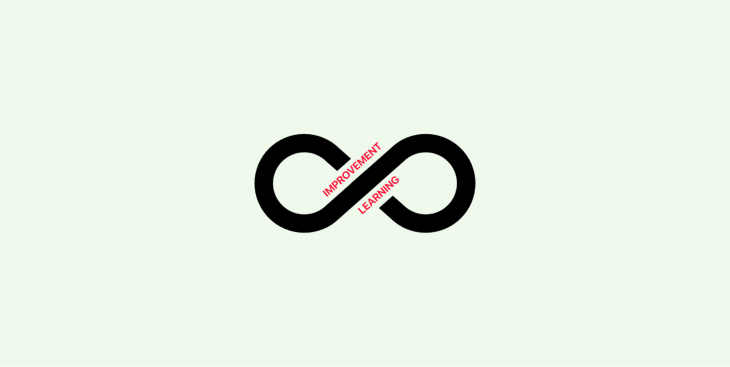
Moreover, continuous learning fosters creativity and innovation within the field itself. It encourages collaboration among designers from diverse backgrounds who share ideas and challenge established norms. Ultimately, this collective growth benefits both practitioners and end users alike — that’s why us developers keep learning.
Online courses are the perfect way to get started in UX design. They’re accessible from anywhere and can be completed on your own time frame. Many online courses also offer flexible scheduling options, so you can take them at your convenience.
Various online platforms such as Coursera, Udemy, and LinkedIn Learning provide a wide range of UX courses. These courses offer learners the convenience to study at their own speed and come with video lectures, assignments, and quizzes that cater to different learning preferences. However, self-discipline for time management is necessary in this format while direct interaction with instructors or classmates may be limited.
Advantages of online courses
Disadvantages of online courses
In-person workshops are a great way to get hands-on experience with UX design. They provide the opportunity to work on real-world projects with other practitioners and receive feedback and instruction from experienced designers.
Workshops typically last for three or four days and offer a variety of courses such as user experience design, interface design, or information architecture. They also offer opportunities to network with other professionals in the field and learn from top-notch instructors.
One of the most popular in-person workshops is UX Mastery, which offers courses in San Francisco, London, and New York. Other popular in-person workshops include UX Boot Camp and UX Design Immersion.
Advantages:
Considerations:
Bootcamps are a great way to get started in UX design. They provide a condensed and intensive learning experience that culminates in a certification or diploma. Bootcamps typically last for two weeks and cover various topics such as user experience design.
Bootcamps typically offer a variety of courses such as user experience design, interface design, information architecture, and web design. They also offer opportunities to network with other professionals in the field and learn from top-notch instructors.
Advantages:
Considerations:
University programs are a great way to get started in UX design. They provide a rigorous academic education with dedicated coursework in user experience design. Universities typically offer a variety of courses such as user experience design, interface design, information architecture, and UX design principles.
Advantages:
Considerations:
When choosing a UX course, carefully evaluate these key factors that will contribute to your success. You want a course that’s worth your money and time!
One essential factor to consider is aligning course offerings with personal learning goals and career aspirations. Each individual has unique objectives they wish to achieve through their educational pursuit. By identifying these specific goals, one can then seek out courses that offer relevant content and resources tailored towards meeting those aspirations.
For instance, you may be looking to grow your research skills. You might be looking for a UX course focused on psychology or data interpretation. If you want to learn an in-demand software, maybe you look for courses on Figma.
Additionally, understanding how the curriculum aligns with your long-term career plans is equally important. It’s vital that the chosen course equips you with the necessary knowledge and practical experience required by employers within the industry you aim to enter.
Assessing whether a program offers hands-on projects, internships opportunities, or even mentorship programs can greatly enhance your chances of securing desired job roles when you complete the course. Therefore, when selecting a UX course, taking into account how well it aligns with both personal learning goals and future career aspirations should be at the forefront of decision-making process
Some key factors to consider when choosing a UX course include:
The learning objectives of a UX course should be tailored to the individual student’s goals and needs. The course content should also be designed to provide the student with the skills and knowledge necessary to design user experiences effectively.
Selecting a UX course that features an experienced instructor will ensure that the course is tailored to your specific needs and goals. In addition, an experienced instructor will be able to provide you with real-world feedback and guidance throughout the course.
The time commitment required for a course should be matched with your availability. Some courses require a significant amount of time, while others can be completed in a shorter amount of time.
Before selecting a UX course, it is important to read the reviews and recommendations of other students. This will help you identify which courses are best suited for your skill level and interests. This can help you identify courses that helped others land jobs.
To get a better understanding of the course content, it is also helpful to view the course syllabus. This document will provide you with a comprehensive overview of the course topics and objectives. Be sure that they’re covering the relevant skills you want to obtain or covering skills you see regularly in job descriptions.
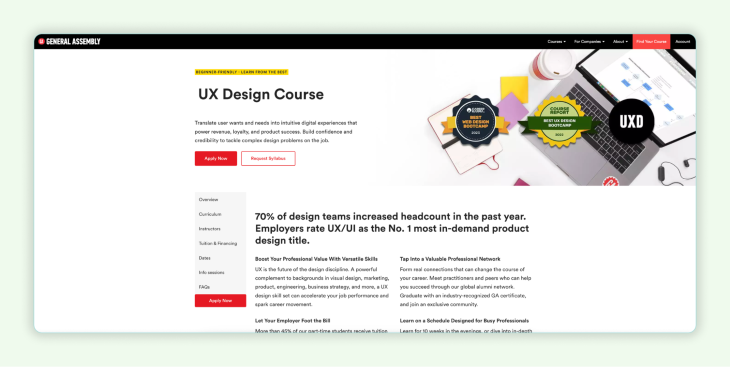
Designed to provide learners with the skills and knowledge they need to excel in User Experience (UX) design, the General Assembly UX Design immersive program is comprehensive and intensive. As a well-known institution specializing in technology, design, and business education, General Assembly offers this immersive course.
Participants in GA’s UX design course get hands-on experience with projects with real-world problems, also exploring a wide array of topics. Instructed by experienced industry professionals and UX experts, students receive a holistic view of UX design as well as the chance to use their newly acquired skills to build an impressive portfolio.
General Assembly also offers several career development resources — from resume creation and networking opportunities to interview coaching — so that participants can make the most out of their newfound expertise.
A number of positive reviews emphasize the course’s practical approach to learning, praising its hands-on nature. Among the major benefits mentioned are the emphasis on developing a portfolio and gaining real-world experience. Career support and networking opportunities are cited as valuable resources for advancing in your career.

In Springboard’s UX Design Bootcamp, participants take a learning journey into user experience design through a structured program. In addition to providing learners with the skills and knowledge needed to succeed in the field of UX design, Springboard is most notably known for its career and industry centric education.
One-on-one mentorship offers tailored advice and assistance throughout the program. Participants can hone their practical abilities with projects that simulate real-world conditions, created in partnership with professionals from the relevant field. Career-focused resources such as interview coaching, networking tips, and job search help are also provided by Springboard. Despite its intensive nature, individuals can still undertake the course flexibly alongside their existing commitments.
Students applauded the thorough and up-to-date curriculum as a great way to develop their UX design skills. They were inspired by the knowledgeable and passionate instructors, who were more than willing to provide assistance outside of class. Learning projects in collaboration with other students offered them great practical exposure that enabled them to sharpen their abilities. Finally, they thanked the career support, which was of tremendous help to secure their desired profession post graduation.
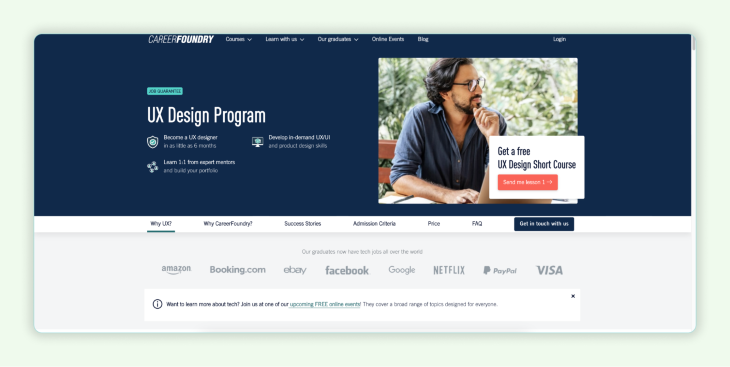
In the CareerFoundry UX Design Program, students learn the skills and experience they need to become UX designers online. There are several topics covered in the course, including:
In addition to working on real-world projects with their peers, students receive career coaching and support to land their dream jobs.
Learn from industry experts and practitioners to become a UX designer. Work on real-world projects with your peers. Create a portfolio to show potential employers your skills.
You will also receive career coaching and support so that you can find your dream job. CareerFoundry also offers a job guarantee, which means you can get your money back if you do not find a job within six months of graduation.
Students praised the curriculum for its in-depth and current content, which gave them the skills they needed to pursue UX design. They commended the instructors for their expertise and commitment to students’ learning, both in class and out.
The projects assigned were well-received, as they offered hands-on practice with peers that furthered their skill development. Finally, the job guarantee offered comfort and assurance of a successful career path post graduation.
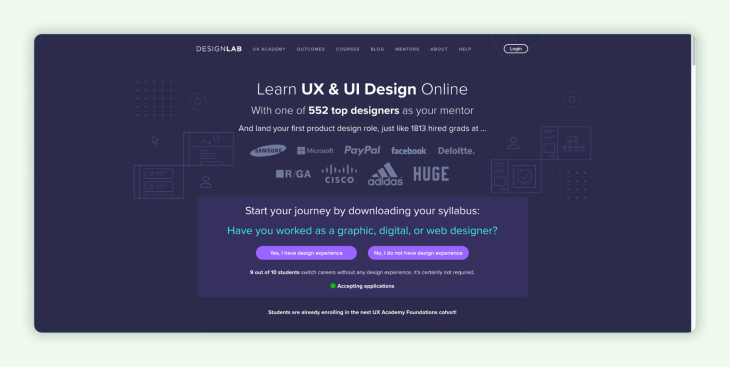
The DesignLab UX Academy course is an online program that teaches students the skills and experience they need to become UX designers. The course covers a wide range of topics, including user research, design thinking, wireframing, prototyping, and usability testing. Students also work on real-world projects with their peers and receive career coaching and support to help them land their dream job.
Learn from industry design leaders and mentors to become a UX designer. Work on real-world projects with your peers. Build a portfolio of your work to demonstrate your skills to potential employers.
DesignLab offers a job guarantee, meaning you can get your money back if you don’t find a job within six months of graduation. Get career coaching and support to help you land your dream job.
One of the most notable aspects of the program is the personalized mentorship, which students praise for its expertise and guidance. Students appreciate the community aspect and the opportunity to connect with peers and mentors, as well as the use of the project-based approach to apply theoretical knowledge to practical scenarios.
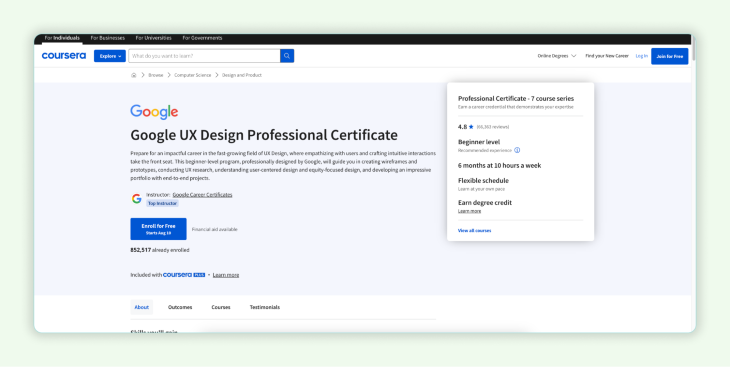
The Google UX Design Professional Certificate, on Coursera, is a program crafted to provide learners with the necessary skills and knowledge required to succeed in the field of User Experience (UX) design. Created in collaboration with Google experts, this certificate program aims to equip participants with practical design skills and insights into user-centered design principles.
As a result of collaboration with Google’s UX design experts, the curriculum is aligned with industry best practices and current trends. As an accredited program from the University of Michigan, the Google UX Design Professional Certificate satisfies rigorous academic standards. The online format on Coursera provides learners with the flexibility to access course materials and complete assignments at their convenience.
Its practical nature and real-world application are appreciated by many learners. Google’s partnership is often cited as a key draw, giving participants confidence in the program’s credibility. Students praise the comprehensive curriculum for being relevant to their career goals as UX designers.
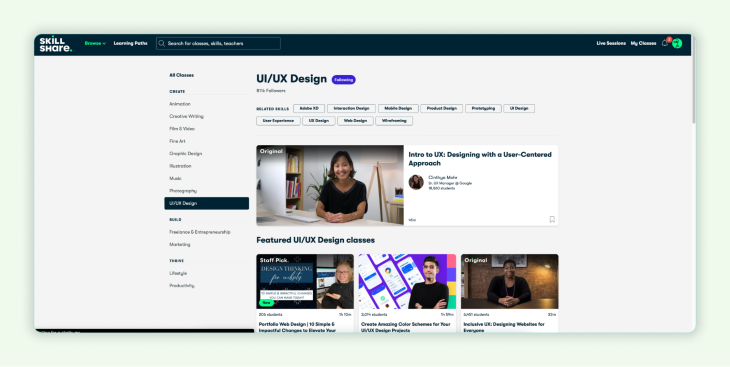
The Skillshare UI/UX design course catalog caters to individuals who are interested in acquiring skills in UI and UX Design. With a focus on creative and practical learning, Skillshare offers learners an accessible platform to explore and enhance their design abilities.
Skillshare offers a comprehensive library of UI/UX Design courses covering a wide range of topics, from UX principles to UI design techniques and tools. Self-paced learning makes Skillshare ideal for busy individuals since it allows them to study at their own pace. UI/UX design learners can take advantage of Skillshare’s subscription model, which includes a wide range of creative courses beyond UI/UX design.
Skillshare’s UI/UX design courses enable learners to create portfolio-worthy work due to their practical and project-based nature. Learners are often given the opportunity to explore different aspects of UI and UX design thanks to the diversity of topics and instructors. As a result of the platform’s flexibility, students are able to manage their studies around their schedules and learn at their own pace.
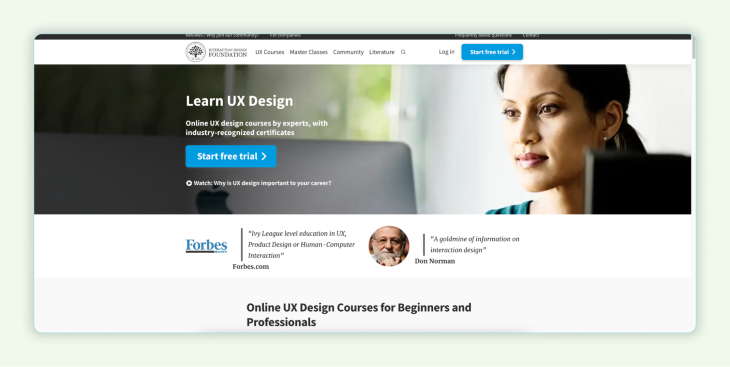
The Interaction Design Foundation (IDF) is a renowned online platform that offers a wide array of courses and resources focused on Interaction Design and UX. The IDF is the place to go for individuals who want to gain a deeper understanding of UX design principles and practices because it emphasizes quality education and a global community.
The Interaction Design Foundation offers a broad selection of courses focused on different facets of Interaction Design and UX Design. They range from basic to highly specialized topics, all supervised by professionals with extensive knowledge in the field. Learners can become part of an international network of UX experts and students while enjoying the flexibility of self-paced learning that fits each person’s specific timetable and study style.
IDF’s community engagement and networking opportunities are often praised by students, who stress the value of connecting with peers and experts. The comprehensive and in-depth curriculum is often cited as a key strength, offering learners a solid foundation in UX design principles. Students appreciate the flexibility of self-paced learning, which allows them to balance their studies with other commitments.
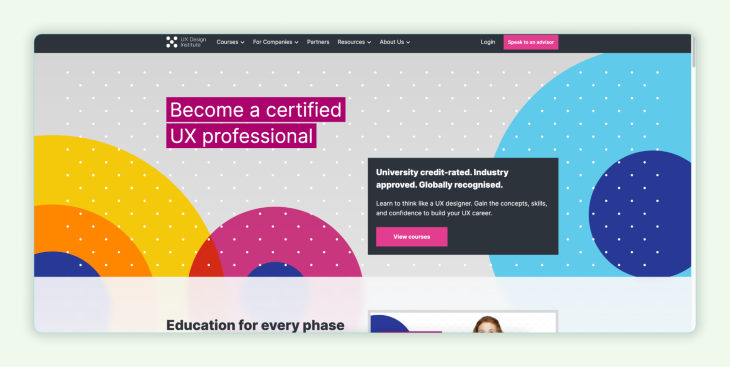
A professional diploma in UX design is offered by the UX Design Institute, catering to individuals who desire a detailed and industry-recognized qualification. In addition to its rigorous curriculum and emphasis on real-world projects, the UX Design Institute is known for preparing participants for success in the competitive UX design industry.
The Professional Diploma in UX Design has international recognition, providing students with a qualified credential that boosts their professional profile. Delivered by experienced industry professionals and UX design specialists, the course encompasses an extensive range of topics to give learners a comprehensive insight into UX principles and practice. To enhance their portfolio, participants can apply their know-how on practical exercises during the program.
Many students praise the curriculum’s practicality, noting the real-world projects that help them apply theoretical knowledge to actual design problems. Personalized feedback and guidance are frequently cited as a valuable resource, with learners appreciating the mentoring aspect. Participants’ professional growth is often attributed to the program’s accreditation and industry recognition.

A wide range of UX design courses are available on Udemy, catering to those interested in learning practical skills and knowledge. Udemy provides learners with a flexible and accessible platform to explore and enhance their UX design skills thanks to its wide range of instructors and topics.
Students can choose from a wide variety of UX design courses on Udemy, each of which covers a different topic and is taught by a different instructor. Udemy courses are often priced affordably, making them accessible to a wide range of learners due to their self-paced nature. Learners are able to adapt their studies to fit their individual schedules and learning preferences.
As noted by student reviews, the courses are practical and applicable, with students praising their ability to immediately apply what they have learned. In addition, learners can find courses that resonate with their learning preferences due to the wide variety of instructors and teaching styles available. One downside is these certifications aren’t widely recognized.
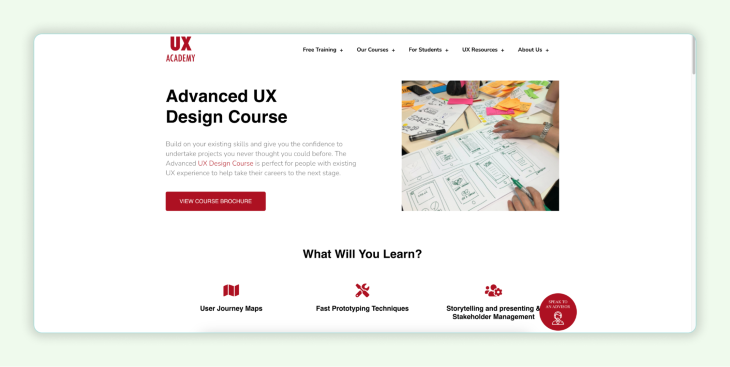
UX Academy is an online course that helps students develop advanced UX design skills. Learners will benefit from the comprehensive knowledge of fast prototyping; storytelling and presenting to stakeholders; creative design thinking; generative and evaluative user research; and Lean UX principles.
UX Academy’s Advanced UX course is a fantastic opportunity for those looking to progress their career in design. It offers certified CPD recognition, plus the chance to learn from the mentors and draw from their vast knowledge of the industry. The course has an extensive curriculum that provides a wide range of skills applicable to current UX positions, so graduates can be sure they have all the required abilities to meet every challenge UX design throws at them.
The participants of UX Academy’s courses have expressed a number of key advantages. These include improved user research skills, like drafting hypotheses, organizing ideation, and synthesizing findings. For those already familiar with UX Design, the program helps to reinforce understanding and practice theories in real-life settings, leading to an impressive portfolio.
Students also praised the classes for boosting their confidence and enthusiasm — these skills can be utilized in work or personal projects, like building websites for family businesses. In a nutshell, people appreciate the program’s value in terms of skill enhancement and its potential to have a deep impact on their careers and other pursuits.
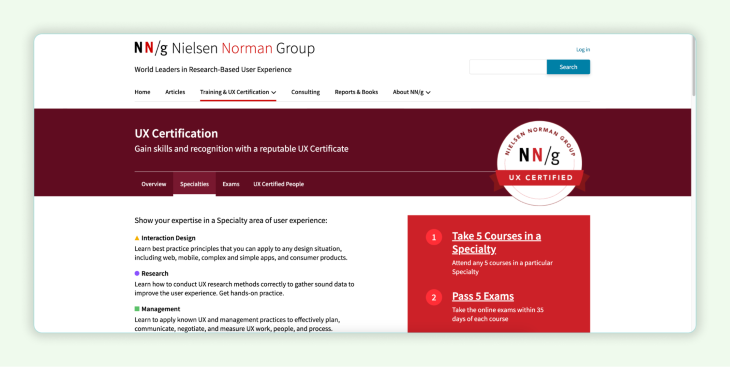
NN group offers two types of certification: the basic UX certification and a master program. The NN group is recognized by many companies as a reputable source for UX knowledge, and their courses match the level of quality of their content.
NN Group’s UX Certification program provides a structured route to gaining a firm grounding in UX design, culminating in attaining the organization’s prestigious credentials. On successful completion of the course, students will be awarded a certification badge that allows them to showcase their UX training on resumes, LinkedIn profiles, and portfolios.
Choosing this program is a promise of perpetual professional development and keeping up with industry advancements. Holding NN Group’s certification increases credibility among both peers in the UX field and potential employers, providing assurance in their UX design capabilities.
NN Group’s UX certification program has earned accolades for its effective organization and responsive customer service. Those involved appreciate the quality of the class materials based on research and insights that can be utilized in future endeavors.
The design classes are enriched with practical advice, while the virtual format offers participants an opportunity to connect, exchange knowledge, and gain insights. The lecturers are highly experienced in their area of expertise. Moreover, graduates gain a respected certificate that amplifies their CV. Furthermore, the online course delivery eliminates transport and accommodation expenses, adding to its ease and affordability.
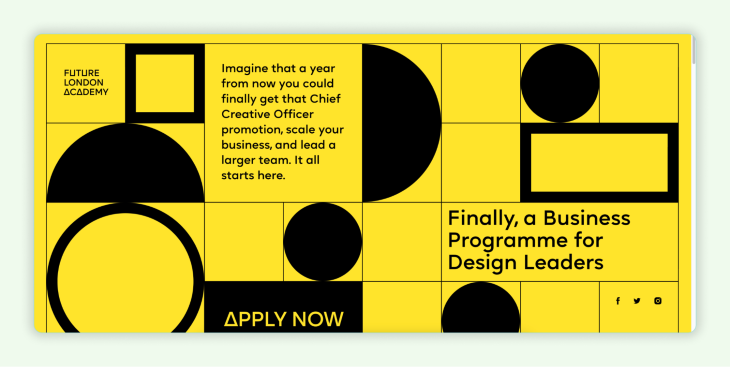
This program is devised specifically for seasoned creative leaders who have 15+ years’ experience. Alongside other creative directors, UX heads, design directors, innovation heads and founders from the globe over, students will benefit from a shared enthusiasm and challenges.
Future London Academy’s UX Design course provides an enriching learning experience, with seasoned instructors delivering practical knowledge across a broad spectrum of topics, from user research to interaction design.
Not only that, but graduates also receive invaluable career coaching and support to equip them with the skills and strategies they need to thrive in the UX industry. What makes this program especially attractive is the chance to create a portfolio of solid hands-on projects that will give students an edge in the competitive job market.
Choosing the right UX course can greatly impact your career prospects and learning journey. Follow these steps to narrow down your options and select the best UX course for you.
Identify your learning goals and career aspirations in UX design. Would you like to start a new career, improve your current skills, or specialize?
Identify reputable platforms, institutions, and organizations that offer UX courses. Consider online platforms, universities, specialized schools, and industry associations.
Take a look at their websites, browse their course catalogs, and learn about the programs they offer.
Ensure that the topics covered in the course curriculum and syllabus align with your learning goals.
Find courses that cover other relevant topics such as user research, wireframing, prototyping, usability testing, and interaction design.
See if the course has any prerequisites, such as prior design knowledge or software skills. Choose a course that matches your current skill level to ensure you can fully engage with the material.
Some courses are intensive bootcamps, while others are part-time or self-paced. Make sure the course fits your schedule.
Whether you prefer online courses, in-person workshops, bootcamps, or university courses, choose the format that suits you best.
You should look for courses taught by experienced professionals who have a proven track record in user experience.
In addition to providing insight into the course quality, instructor support, and overall learning experience, you should also look for reviews and testimonials from previous students.
You should evaluate the course’s cost in relation to its value. Investing in quality education can have long-term career benefits.
Consult peers, colleagues, or mentors in the UX field for recommendations on reputable courses.
Don’t hesitate to contact the course provider’s admissions or support team if you have any questions or need clarification. They can provide additional information and assist with your decision making.
Based on your research, you should compare the courses that align with your goals, offer relevant curriculum, fit your schedule, and provide value for your money.
Finally, choose a course that aligns with your learning goals, skill level, and preferred learning style.
In the rapidly changing digital landscape, User Experience (UX) design is a major factor in developing successful products and services that meet the needs of users. The growing importance of UX has led to an increase in demand for qualified professionals, making it necessary for those interested in staying competitive to pursue continuous learning and professional development through UX courses. This kind of investment in your career can help you become an invaluable asset by keeping you up-to-date with the latest practices and principles in UX design. Explore the available platforms, consider your learning objectives, and begin your journey towards making meaningful contributions to the field by creating user-centric design strategies.
LogRocket's Galileo AI watches sessions and understands user feedback for you, automating the most time-intensive parts of your job and giving you more time to focus on great design.
See how design choices, interactions, and issues affect your users — get a demo of LogRocket today.

Small actions can have large consequences in complex systems. Here’s how UX designers can manage dependencies so users feel informed and in control rather than blocked or blindsided.

This article examines when hero sections are necessary in digital products, when they create friction, and how to evaluate them using UX goals, primary actions, user flow impact, and real-world alternatives.

AI speeds up tasks like research synthesis, ideation, and first-draft wireframes, but it can’t replace clarity, taste, or decision-making. Here’s a grounded look at what AI actually does well in UX right now.

Discover how to craft UX-friendly hero sections with examples, design tips, and strategies that drive engagement and conversion.
One Reply to "12 best UX design courses"
I’d recommend people avoid SpringBoard. The SpringBoard Discord is full of graduate students struggling to find work, and the course material is mostly just blog posts online, and not particularly good ones. The tutors/coaches are encouraging/supportive, but do not actually coach. And that job guarantee they provide has a gotcha – you must complete a minimum number of job applications/week or the guarantee is forfeit, and the minimum is so high you’d never sustain it.